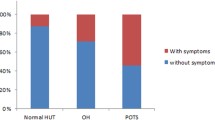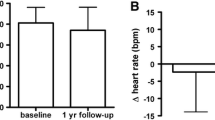Abstract
Patients with postural tachycardia syndrome (POTS) represent a patient population with orthostatic intolerance; some are prone to syncope, others are not. The underlying neurocardiovascular mechanisms are not completely understood. The current study was undertaken to assess if certain cardiovascular indices are predictive of syncope in POTS. We compared the response to tilt-up and the Valsalva maneuver in four groups: POTS patients who fainted (POTS-f;n=11; 31±11 years); POTS patients who did not faint (POTS-nf;n=9; 29±9 years); normal controls (NLS;n=13; 39±11 years); patients with generalized autonomic failure with orthostatic hypotension and syncope (n=10; 59±14 years). Beat-to-beat heart rate (HR), systolic arterial pressure, diastolic arterial pressure (DAP) and pulse pressure (PP) were monitored using Finapres. Cardiac output, stroke volume (SV) and end-diastolic volume (EDV), and calculated total peripheral resistance (TPR) were recorded using thoracic electrical bioimpedance. An autonomic reflex screen which quantitates the distribution and severity of autonomic failure was also done. With the patient supine, all POTS patients (POTS-nf; POTS-f) had increased HR (p<0.001) and reduced SV/EDV (p<0.001) when compared with NLS. On tilt-up, POTS-f patients were significantly different from both NLS and POTS-nf patients; the most consistent alteration was a fall instead of an increase in TPR; other changes were a greater reduction in PP, a reduction (instead of an increment) in DAP, and a different pattern of changes during the Valsalva maneuver (excessive early phase II, attenuated or absent late phase II). Our results suggest α-adrenergic impairment with increased pooling or hypovolemia in POTS-f patients. We conclude that it is possible to identify the mechanism of syncope in POTS patients, and perhaps other patients with orthostatic intolerance and an excessive liability to syncope.
Similar content being viewed by others
References
Bannister R. Multiple system atrophy and pure autonomic failure. In: Low PA, ed.Clinical Autonomic Disorders: Evaluation and Management. Boston: Little, Brown and Company, 1993: 517–526.
Low PA, McLeod JG. The autonomic neuropathies. In: Low PA, ed.Clinical Autonomic Disorders: Evaluation and Management. Boston: Little, Brown and Company, 1993: 395–421.
Streeten DH, Anderson GH Jr, Richardson R, Thomas FD. Abnormal orthostatic changes in blood pressure and heart rate in subjects with intact sympathetic nervous function: evidence for excessive venous pooling.J Lab Clin Med 1988;111: 326–335.
Coghlan HC, Phares P, Cowley M, Copley D, James TN. Dysautonomia in mitral valve prolapse.Am J Med 1979;67: 236–244.
Fouad FM, Tadena Thome L, Bravo EL, Tarazi RC. Idiopathic hypovolemia.Ann Intern Med 1986;104:298–303.
Hoeldtke RD, Dworkin GE, Gaspar SR, Israel BC. Sympathotonic orthostatic hypotension: a report of four cases.Neurology 1989;39:34–40.
Low PA, Opfer-Gehrking TL, Textor SC et al. Comparison of the postural tachycardia syndrome (POTS) with orthostatic hypotension due to autonomic failure.J Auton Nerv Syst 1994;50:181–188.
Rosen SG, Cryer PE. Postural tachycardia syndrome. Reversal of sympathetic hyperresponsiveness and clinical improvement during sodium loading.Am J Med 1982;72:847–850.
Schondorf R, Low PA. Idiopathic postural orthostatic tachycardia syndrome: an attenuated form of acute pandysautonomia?Neurology 1993;43:132–137.
Low PA. Autonomic nervous system function.J Clin Neurophysiol 1993;10:14–27.
Low PA. Laboratory evaluation of autonomic failure. In: Low PA, ed.Clinical Autonomic Disorders: Evaluation and Management. Boston: Little, Brown and Company, 1993:169–195.
Low PA. Composite autonomic scoring scale for laboratory quantification of generalized autonomic failure.Mayo Clin Proc 1993;68:748–752.
Low PA, Zimmerman IR. Development of an autonomic laboratory. In: Low PA, ed.Clinical Autonomic Disorders: Evaluation and Management. Boston: Little, Brown and Company, 1993:345–354.
Benarroch EE, Sandroni P, Low PA. The Valsalva maneuver. In: Low PA, ed.Clinical Autonomic Disorders: Evaluation and Management. Boston: Little, Brown and Company, 1993:209–215.
Low PA. Non-invasive evaluation of autonomic function.Neurology Chronicle 1992;2:1–8.
Ramsay ID. Endocrine ophthalmopathy.Br Med J 1968;4:706.
Sandroni P, Benarroch EE, Low PA. Pharmacological dissection of components of the Valsalva maneuver in adrenergic failure.J Appl Physiol 1991;71:1563–1567.
Opfer-Gehrking TL, Low PA. Impaired respiratory sinus arrhythmia with paradoxically normal Valsalva ratio indicates combined cardiovagal and peripheral adrenergic failure.Clin Auton Res 1993;3:169–173.
Polinsky RJ, Kopin IJ, Ebert MH, Weise V. Pharmacologic distinction of different orthostatic hypotension syndromes.Neurology 1981;31:1–7.
Frohlich ED, Tarazi RC, Dustan HP. Hyperdynamic beta-adrenergic circulatory state: increased beta-receptor responsiveness.Arch Intern Med 1969;123:1–7.
Author information
Authors and Affiliations
Rights and permissions
About this article
Cite this article
Sandroni, P., Opfer-Gehrking, T.L., Benarroch, E.E. et al. Certain cardiovascular indices predict syncope in the postural tachycardia syndrome. Clinical Autonomic Research 6, 225–231 (1996). https://doi.org/10.1007/BF02291138
Received:
Accepted:
Issue Date:
DOI: https://doi.org/10.1007/BF02291138




